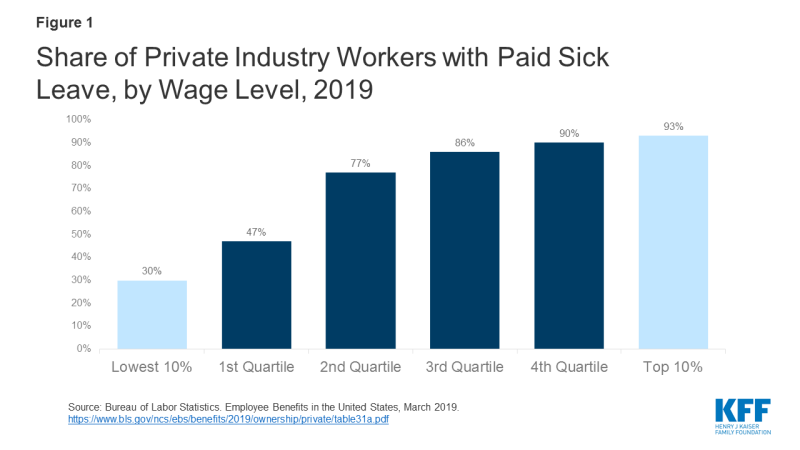Paid Sick Leave is Much Less Common for Lower-Wage Workers in Private Industry
Concerns over the potential spread of the coronavirus have refocused attention on the leave policies of employers. People are being encouraged to remain in their homes if they show any symptoms of respiratory illness, but workers without access to paid sick leave may feel that they cannot afford to miss work, potentially exposing their co-workers and others to the coronavirus or other respiratory illness.
That lower-wage workers are much more likely to lack access to paid sick leave makes their economic decisions more acute. Among the 25% of private industry occupations with the lowest wages ($13.25 per hour or less), 47% have access to paid sick leave; for the 10% of private industry occupations with the lowest wages ($10.48 per hour or less), the percentage with access to paid sick leave falls to 30%. Workers in higher-wage occupations are much more likely to have access to this benefit (Figure 1). For example, 77% of private industry workers with occupations in the second wage quartile ($13.25 to $19.00 per hour) have access to paid sick leave, with the percentage rising to 90% of private industry workers with occupations in the top wage quartile.
A corollary point is that many lower-wage jobs require considerable interaction with members of the general public – just the type of situation where we would want people to elect to remain at home if symptoms arise. Unfortunately, only 48% of private industry workers in leisure and hospitality sector have access to paid sick leave, a much lower percentage than other major occupation categories. These people handle food, money and other items that could be part of the transmission of the coronavirus or other illnesses.
[Visit our special coronavirus topic page for all our resources.]
The potential spread of the coronavirus highlights the issues associated with the lack of paid sick leave for many private industry workers, particularly those with low wages. The lack of access not only exposes these workers to economic hardship if they are forced to miss work, but concerns over lost income may discourage them from seeking health care or missing work when symptoms appear, exposing their co-workers and members of the public to greater risk of transmission.
Methods
The data from this brief is from Employee Benefits in the United States, March, 2019. The data on paid sick leave is available here: https://www.bls.gov/ncs/ebs/benefits/2019/ownership/private/table31a.pdf. We focused in data for workers in private industry; the percentages of lower-wage State and Local Government workers with access to paid sick leave are higher.
The wage percentiles are calculated based on the average hourly wages for occupation into which workers are classified. See https://www.bls.gov/ncs/ebs/benefits/2019/tech_note.htm for a complete description of the methods used. The percentiles were based on the following average wage levels.
| Average Hourly Wage Percentiles | |||||
| 10th | 25th | 50th | 75th | 90th | |
| Private industry workers | $10.48 | $13.25 | $19.00 | $30.61 | $48.28 |

